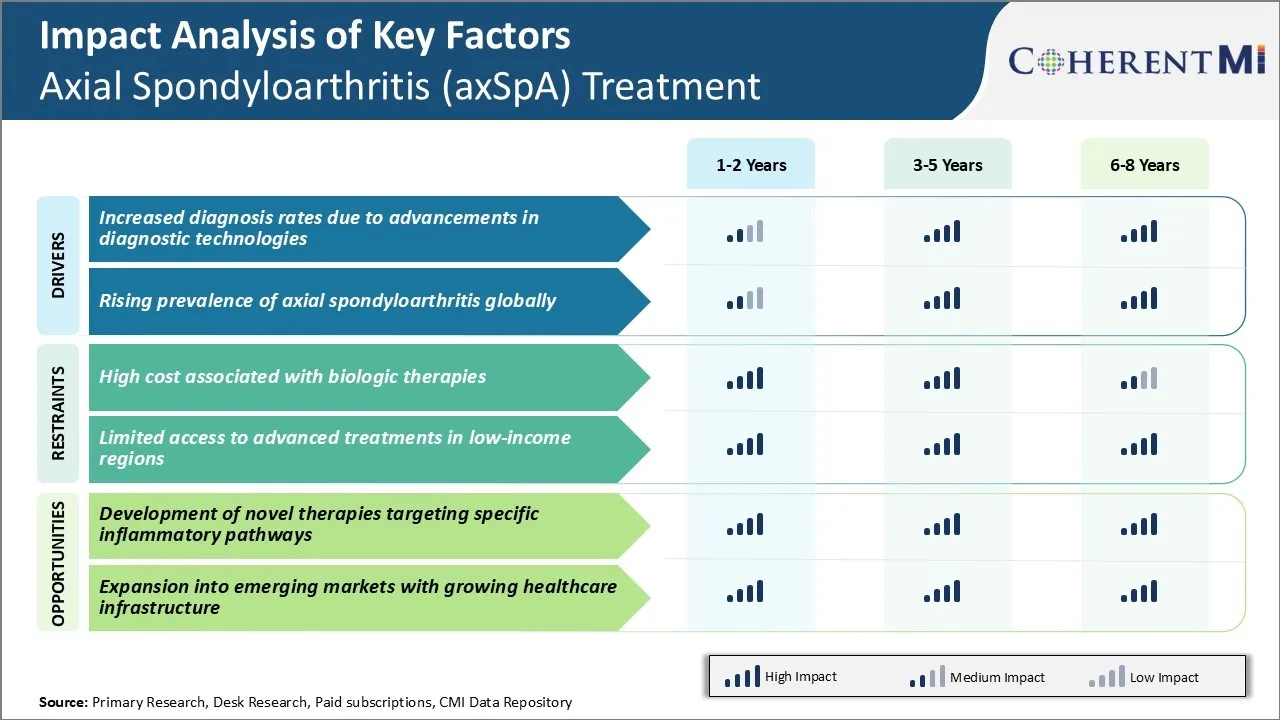Axial Spondyloarthritis (axSpA) Treatment Market Trends
Market Driver - Increased Diagnosis Rates Due to Advancements in Diagnostic Technologies
With the advancements in diagnostic technologies like MRI, more and more cases of axSpA are now being identified at an earlier stage. Earlier, many patients had to suffer for years before getting accurately diagnosed as conventional X-rays could not detect early signs of inflammation and damage in sacroiliac joints and spine.
MRI has been a game changer as it can clearly visualize inflammatory lesions in sacroiliac joints and spine even at a very early or pre-radiographic stage of the disease. As a result, diagnosis rates of axSpA have increased significantly in the past decade.
Pharmaceutical companies have also supported initiatives to spread awareness about early signs and symptoms of axSpA among rheumatologists as well as primary care physicians and orthopedics. As a result, more and more rheumatology practices are adopting the pragmatic approach of using MRI to diagnostic axial spondyloarthritis, rather than relying solely on conventional radiography.
All these factors, including awareness drives and diagnostic guideline changes are cumulatively leading to substantially higher diagnosis rates for axSpA compared to a decade back. This changing disease landscape can be considered as a major driver propelling the axial spondyloarthritis treatment market forward in the coming years.
Market Driver – Rising Prevalence of Axial Spondyloarthritis Globally
Many factors like improved awareness and diagnostic accuracy are resulting in increasing prevalence estimates being reported from retrospective as well as prospective population-based studies. Genetic and environmental influences also play a role in varying disease frequencies between ethnicities and geographical locations. While more work is still required, it is becoming apparent that axial SpA prevalence has been underestimated in the past especially in developing nations with limited research.
Rising disease prevalence naturally translates to an expanding patient population seeking medical attention and therapy over time. This sustained increase in the number of patients with axial SpA will drive sustained demand for approved treatments options worldwide. Given the often-debilitating symptoms of active axial inflammation if left uncontrolled, patients are increasingly willing to adhere to lifelong pharmacological therapy targeting IL-17 and TNF. All top pharmaceutical companies have added axial SpA to their rheumatology pipelines recognizing this growing market potential.
The axial spondyloarthritis (axSpA) treatment market is particularly primed for growth in Asia Pacific and Latin American regions. With rising incomes and implementation of universal healthcare in emerging nations, access to diagnosis and treatment is improving steadily. This will allow more prevalent cases to receive standardized care conforming to ASAS classification criteria.

Market Challenge - High Cost Associated with Biologic Therapies
One of the major challenges in the axSpA Treatment Market is the high cost associated with biologic therapies. Biologics such as anti-TNF drugs are the standard of care for treating axSpA in patients with inadequate response to NSAIDs. However, these biologics are unusually expensive compared to generic alternatives. The list prices of anti-TNF biologics typically range from $20,000 to $50,000 per patient annually in the United States.
Additionally, the costs of treatment are rising as new high-cost specialty biologics enter the axial spondyloarthritis (axSpA) treatment market frequently. The economic burden caused by these high drug prices often poses difficulties for public and private payers to provide affordable treatments for patients. It could potentially reduce access to life-changing medications and worsen the overall healthcare outcomes.
Manufacturers will need to explore strategies to make these vital treatments more affordable and cost-effective without compromising quality. This remains a major challenge hampering overall market growth.
Market Opportunity - Development of Novel Therapies Targeting Specific Inflammatory Pathways
One of the key opportunities in the axSpA Treatment Market lies in the development of novel therapies targeting specific inflammatory pathways for which unmet needs exist. Currently, anti-TNF therapy is the standard treatment but not all patients respond to it. Moreover, there are safety concerns with long-term use of anti-TNF agents. This necessitates research into new therapeutic approaches.
Projects are ongoing to develop next-generation biologics inhibiting cytokines like IL-17, IL-23, as well as small molecules targeting JAK and other pathways. A promising pipeline with diversified mechanisms has potential to address primary as well as secondary non-response to existing therapies.
Successful introduction of innovative medications with better safety profiles and new targets will offer patients more effective treatment options. It could also capture a larger share of the axial spondyloarthritis (axSpA) treatment market and drive stronger revenue growth for pharmaceutical companies in the long run.